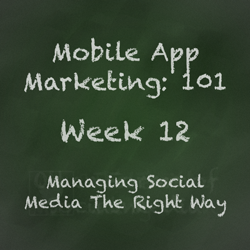It’s pretty evident that social media plays a very important role in not only marketing your application, but in listening and interacting with your customers. Learning what they like, what they don’t like, new features they might want, what the competition is doing, there is a wealth of knowledge out there, but how do you keep track of it all? Trying to listen to all different social channels for a wide variety of keywords and phrases is more than a full-time job.
This week we’ve gathered some of the tools you can use to manage social media, not only writing posts, tweets, and statuses, but also listening to what others have to say and monitoring the social media universe.
From the mundane “Get Your Family to Download Your App” to the off the wall “Create Beer Coasters” join us on a 52-week journey of some of the top ways to promote and market your mobile application.
Week 12
Tools For Managing Your Social Media
 We’ve seen how many different platforms you can use to broadcast your company’s message. Some organizations stick to Facebook and Twitter, while others use anything and everything they can in order to promote their app. No matter what your approach is, it’s essential to decide on how you want your social media team to handle the multiple platforms that your company uses.
We’ve seen how many different platforms you can use to broadcast your company’s message. Some organizations stick to Facebook and Twitter, while others use anything and everything they can in order to promote their app. No matter what your approach is, it’s essential to decide on how you want your social media team to handle the multiple platforms that your company uses.
It’s certainly a viable approach to manage each platform on its respective website – but it may not be the most convenient or efficient. This week we’re discussing the various management suites exist that let you prepare and post social media content, all the while giving you a good look at what your customers think and how they’re responding to your posts.
HootSuite
By far one of the most popular social media management tools, HootSuite allows you to simultaneously monitor the feeds of each of your brand’s social media accounts. The suite allows you to schedule posts across multiple platforms, letting your news and content get seen by your followers no matter where they are. HootSuite also allows for multiple users to access the same social media accounts, which ultimately translates into greater coordination between your company’s marketing and social media teams.
Buffer
 Buffer’s key strength lies in its scheduling capabilities – namely, that you can create posts and then let Buffer post them at times when they will receive maximum exposure and interaction. The suite also enables users to post content directly through the use of a browser button; in other words, your social media team could create and post content directly from your company website without having to write a new post.
Buffer’s key strength lies in its scheduling capabilities – namely, that you can create posts and then let Buffer post them at times when they will receive maximum exposure and interaction. The suite also enables users to post content directly through the use of a browser button; in other words, your social media team could create and post content directly from your company website without having to write a new post.
Sprout Social
 The ultimate goal of social media is acquiring new customers and keeping current ones engaged with your brand; with that in mind, Sprout’s unique CRM system is what makes their social media suite one of the best. Sprout keeps a record of each interaction you have with a user across the social media platform. For example, if a potential customer responds to a tweet, Sprout will log that user’s Twitter handle and allow you to later build a customer profile for them. The suite even allows for cross-integration with sales solutions like Zendesk and Salesforce.
The ultimate goal of social media is acquiring new customers and keeping current ones engaged with your brand; with that in mind, Sprout’s unique CRM system is what makes their social media suite one of the best. Sprout keeps a record of each interaction you have with a user across the social media platform. For example, if a potential customer responds to a tweet, Sprout will log that user’s Twitter handle and allow you to later build a customer profile for them. The suite even allows for cross-integration with sales solutions like Zendesk and Salesforce.
Expion
 Expion is used by some of the largest companies in the world (e.g. conglomerates and blue chips). With management tools that can handle thousands of individual pages, it’s one of the best tools available for companies that have to simultaneously maintain an online presence across multiple apps, products, or brands. Expion also features “listening” features that let you know when and where a site’s users are talking about your company or brand. Trend detection and extensive interaction analytics make this a truly powerful social media management tool.
Expion is used by some of the largest companies in the world (e.g. conglomerates and blue chips). With management tools that can handle thousands of individual pages, it’s one of the best tools available for companies that have to simultaneously maintain an online presence across multiple apps, products, or brands. Expion also features “listening” features that let you know when and where a site’s users are talking about your company or brand. Trend detection and extensive interaction analytics make this a truly powerful social media management tool.
Each social media management suite has its own benefits, and it’s important to carefully review your options before making a purchase decision. However, many pricing plans operate on a month-to-month basis, so if you find yourself unsatisfied with the solution you chose, it should be easy enough to jump ship.
As our social media month comes to a close, it’s important to remember that Internet media is nebulous, dynamic, and frantic. Social media changes faster than anyone can keep up with, so it’s important to stay on top of what people are talking about and to decide how (or if) your app fits into that conversation. Marketing guru Gary Vaynerchuk famously states that “content is important but context is key”. In the same way that you must find a place in the market for your app, you must also find a place in the social sphere for it.
As always, you can follow us on Twitter and Facebook to keep up.
What tool do you currently use to manage your social media?
The 52 Week Series of Marketing Mobile Applications
Week 1: Talk to Friends & Family
Week 2: Picking the Right Name for Your App
Week 3: App Store Optimization
Week 4: Submitting Your App to Review Sites, Blogs, and Directories
Week 5: Using Video to Promote Your App
Week 6: Creating a Microsite
Week 7: Creating a Press Kit
Week 8: Creating a Marketing Plan
Week 9: Social Media: Facebook
Week 10: Social Media: Twitter
Week 11: Social Media: Other Platforms
Week 12: Social Media: Other Platforms







One Response
How can i find all 52 weeks of this series? Or at least anything past week 12? Also, any information on how to develop a “Text To” number that people can use with the return text being a link to the app?
Thanks!